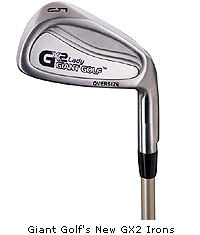 Select
the Perfect Select
the Perfect
Iron Set for Your Game
By Frank J. Peter, editor at LearnAboutGolf.com
Having a good set of irons that you can trust is very comforting.
Sure, driving the ball is fun, but in a round of golf it's the irons
you count on to get you on the green and in position to do well.
The good news is that modern technology has made irons easier to
hit than ever. This buyers' guide will help you learn the basics
of iron design, how they've improved, and which clubs are best suited
for your game.
Iron Essentials
Most iron sets consist of a 3-iron through pitching wedge (listed
as 3- PW). This accounts for 8 of the 14 clubs you can carry according
to the Rules of Golf, leaving room for a putter and three woods.
Some players substitute a high-lofted wood for the 3-iron because
they find it easier to hit. This is a good strategy. However, stronger
players who don't have a problem getting the ball up may still prefer
to use the more accurate long irons. Here's a guide to the key features
of today's woods:
Blade versus cavity-back
A blade iron offers a smaller hitting surface and a thin top-line
(portion of the clubhead viewed at address). It also has more mass
behind the middle of the clubhead, sometimes called a "muscle-back,"
that gives a very soft feeling when hit properly. In contrast, a
cavity-back or perimeter-weighted club has more weight around the
outside edges of the clubhead to produce a larger sweet-spot. The
easiest-hitting irons of all generally have a large cavity-back,
thick top-line, and oversize clubface. But increasingly, club makers
are offering designs that incorporate the forgiving benefits of
cavity- back in a blade style with a thinner top-line. For many
traditionalist golfers, this is the answer. Casting versus forging
Up until the early 1970s, forged steel clubheads accounted for more
than 90% of all irons made. This model involves hammering and shaping
the clubhead. Now, investment casting has taken over as the primary
manufacturing method. Casting, in which the metal is poured into
a mold, costs less and makes it easier to produce the complex shapes
of today's perimeter-weighted, cavity-back designs within tight
specifications. However, forging is not likely to disappear because
many golfers believe it offers better feel and ball "workability."
It also offers a cleaner look for the tradition-minded golfer. Hosel
offset This is measured from the leading edge of the hosel (where
the shaft enters the clubhead) to the farthest front portion of
the clubface. Why is it important? A club with offset contacts the
ball later than a club without offset. This helps "square"
the clubface at impact and reduces the tendency to slice (ball going
right for right-handed golfers). Progressive weighting This involves
placing a heavier material, such as copper or tungsten, in the sole
of lower-lofted irons. This helps lower the center of gravity and
get the ball in the air. Progressive weighting is generally eliminated
in the shorter irons to help produce a lower, flatter trajectory.
Grooves or scoring lines
Grooves add spin and control to the ball's flight. An iron with
no grooves causes the ball to "squirt" off the face. Backspin
may decrease distance slightly but greatly enhances control. Karsten
Solheim, legendary founder of Ping, brought attention to the value
of grooves when players of his clubs with larger, sharper grooves
began showing superior control - especially out of rough lies. The
USGA strictly controls the depth and distance between scoring lines
on the clubface to ensure fairness. Lie This is the angle of the
sole (bottom) of the club as it relates to the shaft. Too "flat"
a lie places the heel of the club in the air, while too upright
a lie angle causes the toe to be in the air at address. Loft This
is the clubface angle relative to the shaft, and determines the
trajectory of your shots. It varies from about 22 degrees in a 3-iron
for a lower, longer trajectory to 64 degrees in a wedge for short,
high shots. Satin finish vs. polish or chrome This is merely a cosmetic
question. A satin finish can be very attractive, but in general
has a duller appearance than polished or chrome-finish clubheads.
Sole
This is the very bottom part of the clubhead. If you look closely
at the sole of your club, you'll notice it has a slight curvature
from toe to heel and from leading edge to trailing edge. This "camber"
or "radius sole" makes it easier to hit consistent shots.
Sole width is another factor. A narrower sole works better from
fairway and tight lie conditions while a wider sole is better for
plush lies.
Frank J. Peter is the CEO of LearnAboutGolf.com, a free website
especially for the golf beginner offering extensive golf lessons
and golf tips, a golf fitness section, a Lady Golfer section, golf
equipment reviews, free newsletter and more.
Irons
|